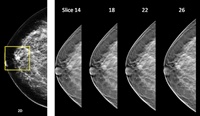Detecting breast cancer: 3-D screening reduces recall rates
By By Helen Dodson | 30 Jul 2013
Tomosynthesis, or 3-dimensional (3-D) mammography, significantly reduced the number of patients being recalled for additional testing after receiving a mammogram, a Yale Cancer Center study found. The study appears in the journal Radiology.
 | |
| (On the left) conventional 2-D mammography shows a potential lesion. The four 3-D tomosynthesis images to the right show there is no lesion present. (Image courtesy of Hologic, Inc.) |
Digital mammography is considered the mainstay for breast cancer screening. However, it is not a perfect test, and many women are asked to come back for additional testing that often turns out not to show cancer. These additional screening tests increase patient anxiety.
Tomosynthesis creates a high-resolution, three-dimensional reconstruction of the breast, which can then be viewed as sequential slices through the breast. Tomosynthesis has been shown to increase the visibility of many lesions, and helps to distinguish potentially cancerous findings from otherwise normal breast tissue.
The Yale researchers studied more than 13,000 patients who were screened. Of these, 6,100 received tomosynthesis plus mammography, and 7,058 underwent conventional digital mammography alone. The recall rate was 8.4 per cent for patients in the tomosynthesis group, and 12 per cent for the mammography-alone group.
''The addition of tomosynthesis resulted in a 30 per cent reduction in the overall recall rate,'' said first author Dr. Brian Haas, in the diagnostic radiology department of Yale School of Medicine.
''This recall reduction benefitted women of all breast densities and in all age groups, but particularly for those younger than 50, and those with dense breasts,'' said corresponding author Dr. Liane E. Philpotts, professor of diagnostic radiology at Yale School of Medicine. ''Reducing recall rates means there will be fewer patients anxious about getting called back, and it means that there will be downstream cost savings for the healthcare system,'' she added.
The study did not reveal a statistically significant difference in actual cancer detection between the two groups. However, Philpotts cautioned, ''This does not mean that one does not exist. Ongoing data collection since this study is showing a higher rate of cancer detection with tomosynthesis than without it. We will need a larger number of patients to see more precisely what exactly the effect is on cancer detection.''
Other authors are Dr. Vivek Kalra, Dr. Jaime Geisel, Dr. Madhavi Raghu, and Dr. Melissa Durand of Yale.













.jpg)






.jpg)









